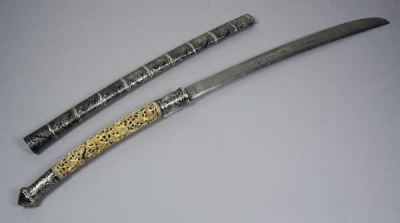Dha (1968.23.55)
 BurmaDha from Myanmar, Asia. Thought to have been collected by Henry Baden-Powell by 1901. Given to the Museum by Donald Ferlys Wilson Baden-Powell in 1968.
BurmaDha from Myanmar, Asia. Thought to have been collected by Henry Baden-Powell by 1901. Given to the Museum by Donald Ferlys Wilson Baden-Powell in 1968.
The dha is the national sword of Myanmar, the country alternatively known as Burma. It has a distinctively long cylindrical grip for use with two hands and is stylistically similar to the curved sabres of China, Thailand, Korea and Japan. In fact, the name for this weapon is remarkably similar in all these places: among Tai speakers it is known as a darb or daarb and in Tibeto-Burman and Chinese languages it may be called dao.
It is thought this very ornate example was collected in the late 19th century by Henry Baden-Powell, half-brother of Robert Baden-Powell, founder of the Scout movement.
The Art of War
This is an extremely high-quality dha in the ornate Rangoon style. Although it shares a stylistic ancestry with other one-edged, curved swords of East Asia, Burmese swords lack any significant guard. Traditional Burmese warfare involved the besiegement of forts with stockades 2.5 to 5 metres high. Musketry and artillery were used to breach the stockades, after which hand-to-hand combat ensued, using dhas such as this.
The carved elephant ivory hilt is a particular high point of this artefact, representing four galleries of Hindu figures in high relief. These include two bearded and crowned figures, representing Rama and his brother-in-law, as well as several fanged rakshasa demons. These characters feature prominently in the mythology of Hindu South East Asia through the epic Ramayana. The ivory carving also features a peacock motif, which symbolises Paravani, the vehicle of Subrahmanya, the southern Hindu god of war and son of Shiva.
The wooden scabbard is encased with silver and depicts a number of modelled repoussé flowers and animals, framed in rectangular cartouches, which give the sheath a 'banded' effect. The inclusion of animals may reflect a South Asian concern to show creatures of the hunt on weapons of war. There is a circular, red Rajput shield from north-west India in this gallery which is another fine example of the same phenomenon. In conclusion, this sword is both artwork and weapon, which embodies the qualities of the noblest warriors and the gods of war, and places them in the hands of the warrior himself.





